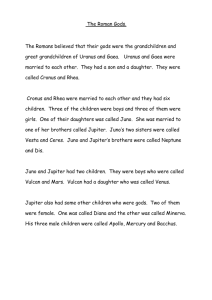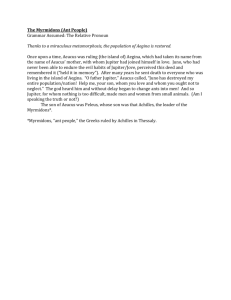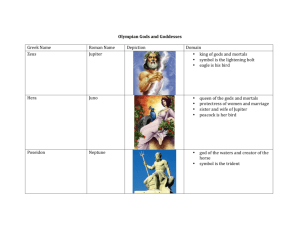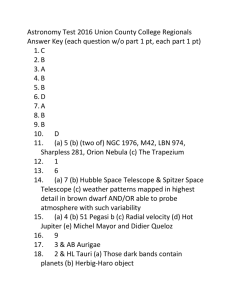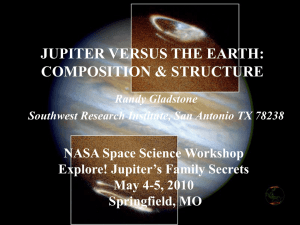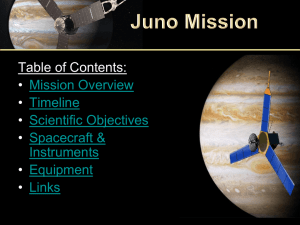Janssen - University of Idaho
advertisement
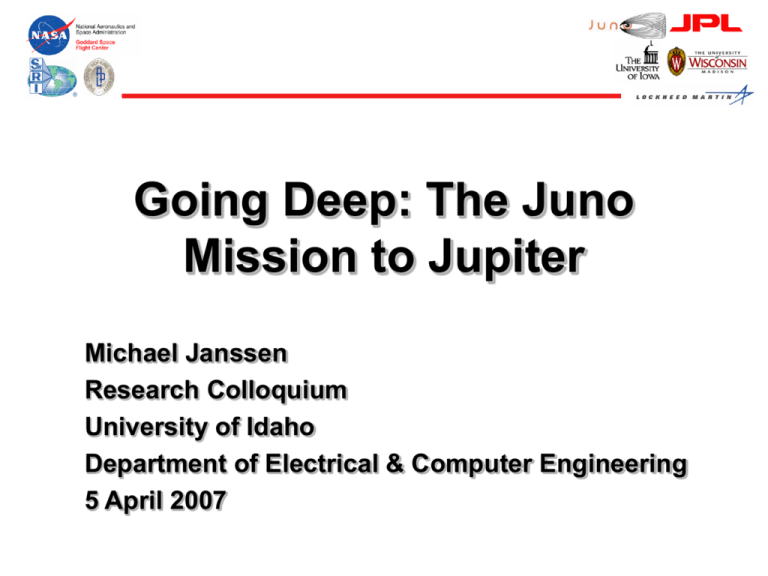
Going Deep: The Juno Mission to Jupiter Michael Janssen Research Colloquium University of Idaho Department of Electrical & Computer Engineering 5 April 2007 Outline • Juno Mission • The Juno Microwave Radiometer Experiment Juno • Juno is a new mission to Jupiter – 1st competed New Frontiers Mission • Experiments: – Gravity Science Experiment • Doppler tracking – Magnetic Field Investigation • Magnetometers & star camera – Microwave Radiometer (MWR) • 6 Frequencies 0.6 - 23 GHz – Polar Magnetospheric Suite • 5 Instruments Mission Timeline: May 2005 Juno Selected Jan 2006 Phase B start August 2011 Launch October 2013 Earth Flyby August October 2016 Jupiter Arrival – Junocam, optical camera for EPO October 2017 Mission End Website: http://www.juno.wisc.edu/ 2017-2018 Data Analysis Juno From Mount Olympus, Juno, the god-sister-wife of Jupiter, ruler of the heavens, kept a constant and jealous vigil over her god-husband. When Jupiter had his trysts with Io he spread a veil of clouds around the whole planet to conceal his dalliance from Juno. Juno perceived the planet to suddenly grow dark, and immediately suspected that her husband had raised a cloud to hide some of his activities that would not bear the light. The cloud cover served only to arouse Juno's suspicions, and she came down from Mount Olympus. With her special powers, she penetrated the cloud to see the true nature of Jupiter. Science Team PI Scott Bolton, SWRI Interior Atmosphere Magnetosphere Mike Allison John Anderson Sushil Atreya Fran Bagenal Michel Blanc Jeremy Bloxham Jack Connerney Angioletta Coradini Stan Cowley Daniel Gautier Randy Gladstone Tristan Guillot Samuel Gulkis Candice Hansen William Hubbard Andrew Ingersoll Michael Janssen Michael Klein William Kurth Steve Levin Jonathan Lunine Barry Mauk David McComas Tobias Owen Ed Smith Paul Steffes David Stevenson Ed Stone Richard Thorne Juno Science Objectives Origin Determine O/H ratio (water abundance) and constrain core mass to decide among alternative theories of origin. Interior Understand Jupiter's interior structure and dynamical properties by mapping its gravitational and magnetic fields Atmosphere Map variations in atmospheric composition, temperature, cloud opacity and dynamics to depths greater than 100 bars at all latitudes. Magnetosphere Characterize and explore the three-dimensional structure of Jupiter's polar magnetosphere and auroras. Probing Deep and Globally Juno probes deep into Jupiter in three ways: • Radiometry probes deep into meteorological layer • Magnetic fields probe into dynamo region of metallic hydrogen layer • Gravity fields probe into central core region Spacecraft Characteristics Mag Boom Spin-Stabilized Rad-Hard Solar-Powered 20+ m Diameter Trajectory Y DSM, 9/18/12 (date varies) Earth flyby, 800 km alt., 10/18/13 Jupiter Arrival, 10/19/16 8/2/16 X Launch, 8/18/11 View from above ecliptic plane with ecliptic X to right Orbits • Juno makes 31 highly eccentric orbits of 11 days each • The eccentric polar orbit allows the spacecraft to get close to Jupiter without getting fried in the intense radiation belts Orbit Trajectory 31st orbit is shown QuickTime™ and a BMP decompressor are needed to see this picture. Magnetic Investigation • Led by Jack Connerney (GSFC), with Ed Smith and Neil Murphy (JPL) • The Juno MAG experiment maps the innermost magnetic field structure of Jupiter at all longitudes • Measurement system has the following components: – Dual Fluxgate Magnetometers for vector field (GSFC) – Advanced Stellar Compass (ASC/DTU) for attitude determination – Scalar Helium Magnetometer for field magnitude (JPL) – Dedicated MAG boom at end of the solar array Multiple polar orbits phased to map Jupiter’s magnetic field Magnetic Field Mapping QuickTime™ and a Cinepak decompressor are needed to see this picture. Gravity • Led by John Anderson, Anthony Mittsakus • Precise measurements of spacecraft motion measure gravity field • Juno polar orbit measures full gravity field • Distribution of mass reveals core and deep structure Close polar orbit is ideal to measure Jupiter’s gravity field Gravity Determination of Core Mass and Deep Winds • J2, J4, J6 and tides give core mass once water abundance is known • J8 - J30 give deep winds down to r ~ 0.8 RJ • Red is signature of deep winds; dash is signature of solid body rotation • Blue dots (X/Ka uplink) show accuracy for baseline mission Jupiter’s Polar Magnetosphere • Jupiter’s aurora from the Hubble Space Telescope (Clarke et al.) QuickTime™ and a H.264 decompressor are needed to see this picture. QuickTime™ and a PNG decompressor are needed to see this picture. Shown in magnetic coordinates Rotating with Jupiter Auroral Investigation Polar Magnetosphere Suite: • Jovian Aurora Distribution Experiment (JADE) – • Energetic Particle Detector (EPD) – • – – – – Currents EM emissions Energetic particles & plasma UV and IR auroral emissions Randy Gladstone (Southwest Research Institute) Jovian InfraRed Auroral Mapper (JIRAM) – • Juno instruments will measure: William Kurth (University of Iowa) UV spectrograph (UVS) – • Barry Mauk (APL/Johns Hopkins University) WAVES (radio & plasma spectral measurement) – • David McComas (Southwest Research Institute) Angioletta Coradini (Agenzia Spaziale Italiana) MWR Science Objectives Microwave sounding will address two key questions: How did Jupiter form? How deep are the atmospheric circulations? > 200 bars? Water is key to understanding the formation of Jupiter. We need to distinguish between 3solar and 9solar abundance. ~ 6 bars? Cosmic Abundances Why is Water Important? H2O, NH3, CH4 Water, Ammonia, Methane Hydrogen compounds Galileo Probe Results for Jupiter’s abundances • Galileo results show similar enrichment, independent of volatility • Results imply Jupiter formed colder and/or further out than 5 AU • Solid material that enriched Jupiter was most abundant solid material in early solar system Galileo showed us planetary formation theories were wrong Microwave Radiometry • Led by Michael Janssen • Radiometry sounds atmosphere to 1000-bar depth • Determines water and ammonia global abundances • 6 wavelengths between 1.3 and 50 cm The First Deep Space Radiometer • • • • 20 lbs, 5 w 1.9 and 1.35 cm-l Crystal detectors (!) 5-month project start to delivery (!) • Verified hot surface, deep atmosphere Flight Microwave Radiometers Since Mariner 2 • Planetary (dedicated radiometers) – 0! • Earth-orbiting – Lots (too numerous to list) • Other Planetary – MIRO (submillimeter spectrometer) – Magellan (incorporated into radar instrument) – Cassini (incorporated into radar instrument) • Future planetary – Juno Microwave Radiometer Resolution is a Problem 30 km 3 km 300 m Aperture size for 1 arcsec resolution 30 m 3m 30 cm 1 mm 10 mm 100 mm 1 mm 1 cm Wavelength 10 cm What do We See in the Microwave Region? Jupiter, 20 cm-l Jupiter, 2 cm-l Cosmic background, thermal fluctuations at mm-l (from WMAP) Energetic Electrons Thermal Blackbody Spectral lines Synchrotron emission Thermal bremsstrahlung 10m 1m 10 cm 1 cm Wavelength 1 mm 100 mm Planetary Science Targets radiometry Particles and Fields spectroscopy Deep Atmospheres Upper Atmospheres Surfaces Composition Winds Energetic Electrons Thermal Blackbody Spectral lines Synchrotron emission Thermal bremsstrahlung 10m 1m deep 10 cm 1 cm Wavelength Surfaces 1 mm shallow 100 mm Specific Intensity (J s-1 m-2 ster-1 Hz-1) Planck’s Radiation Law Wavelength -12 10 1E-12 10 cm 1 cm 100 mm 1 mm 10 mm 1 mm 3000 K 1E-13 -14 10 1E-14 Rayleigh-Jeans limit: h kT 1E-15 B T -16 10 1E-16 1E-17 2k l 2 300 K T -18 10 1E-18 30 K 1E-19 Planck function: 1E-20 10 0.1mm -20 2h 3 1 B T 2 h / kT c e 1 3K 1E-21 -22 1E-22 10 1E-23 -24 1E-24 10 0.1 1 10 Frequency (cm-1) 100 1000 10000 100000 Brightness Temperature In microwave region, brightness of a Blackbody is linear with kinetic temperature T: B T 2k l 2 T Iv Redefine radiant intensity in units of Kelvin by scaling: TB l 2 2k I This is “Brightness Temperature” Atmospheric Sounding T(h) Radiative transfer equation: TB f W h, f T h dh 0 f1 h f2 where W(f) = weighting function at frequency f W(h) Atmospheric Sounding (continued) T(h) • Weighting function depends on composition – E.g., NH3, H2O f1 h • Brightness spectrum tells about the distribution of: f2 – Temperature – Composition W(h) Jupiter Seen from the Earth Resolution on Jupiter’s microwave brightness is modest Jupiter, 2 cm-l at present Jupiter, 20 cm-l The Cassini RADAR Radiometer 4-M Radar Location The radiometer is built into the Radar receiver system • • • • • • Frequency = 13.68 GHz (2.1 cm l) Beamwidth = 0.35° (uses the HGA) Measurement precision 0.025K /s Absolute uncertainty 2% Polarization: 1 linear Observes in all RADAR modes: – – – – Radiometer only Scatterometer Altimeter SAR (5 beams alternating) • Science Objectives – – – – Titan Rings Saturn atmosphere Icy satellites Saturn at Microwave Frequencies • Best previous maps of Saturn at millimeter/centimeter wavelengths are Earth-based: (from Grossman, Muhleman, & Berge, 1989) Saturn from Cassini • 2.1-cm image formed by continuous pole-to-pole scanning in three separate time segments • Shows NH3 cloud humidity, seen to vary 100% MWR Sounding • The Juno microwave instrument will use six radiometers to measure the thermal emission from Jupiter’s deep atmosphere • Ammonia and water are the principal sources of microwave emission • Their concentration and distribution will be measured solar panels spin axis 25-cm l antenna 12.5, 6.25, 3.125, 1.3-cm l antennas 50-cm l antenna Juno Observations • Unique microwave measurements obtained Spacecraft tracks 10° footprints –Synchrotron emission avoided –High spatial resolution obtained Emission angle dependence uniquely measured by alongtrack scanning This is a new and powerful approach Along-track scanning Jupiter’s Spectrum Measured from Earth De Pater et al., Icarus 173, Vol 2, pp 425-438, 2005 Ammonia Opacity only Ammonia and Water Opacity Water’s Effect on the Spectrum Very high accuracy is required to measure water abundance using brightness temperature spectrum • Inversion requires measurements at different wavelengths 2 % accuracy • Knowledge of the absolute gains at the 2% level is very difficult • Uncertainties in gains at different wavelengths are uncorrelated • Another technique is required! Emission Angle Dependence Off-Nadir View Nadir View R(%) = Tb (nadir) – Tb () Tb (nadir) 100 R is a dimensionless parameter that can be measured to high precision (Janssen et al., Icarus 173, 2005, 447-453) Two-Point Spectrum of Relative Brightness • Relies on relative measurement that can be measured to precision of 0.1% • Does not rely on absolute calibration that is limited to 2% • Note: not restricted to 2 points Juno Spacecraft Forward LGA MGA 2X Spinning Sun Sensor 2X Battery 2.5 m HGA (Fix-Mount) Electronics Vault SASU Fwd REM Fwd REM Thermal Louver Solar Array Articulation Mechanism MWR Antenna Panel MWR 600 MHz Antenna MWR Antennas All 12° Beamwidth (Full-Width at Half Power) 600 MHz 4.8 GHz 20° Beamwidth (Full-Width at Half Power) 9.6 GHz 23 GHz 2.4 GHz 1.2 GHz Patch Antenna for 0.6 and 1.2 GHz Antennas Patch Radiator (cavity resonator) Honeycomb Support Structure Coax fed probe from feed to patch Feed Network (power dividers) Rear View Cross-Sectional View Computed Radiation Patterns for Patch Antennas Full-size 5x5 patch array, f=0.6GHz, MoM cuts, inf. GP 0 spec 20° -10 E-total (dB) -20 -30 -40 -50 -60 -80 -60 -40 -20 0 20 theta (deg) 40 MoM Analysis on Infinite Ground Plane 60 80 2.4 - 9.6 GHz Antennas • 2.4 - 9.6 GHz Antennas will be 8x8 Waveguide Slot Array Antennas (5x5 Slot Arrays Shown) Half-wavelength slots leak power into the radiation field in a precisely controlled manner Top View Metal waveguides form a sturdy box beam mechanical structure Top View – Radiating Face Removed Breadboard of 1.2 GHz Radiometer DC side RF side Bandpass Filter LNA LNAs Lowpass Filter Detector Circuits Bandpass Filter Noise Diode Isolator Test Port Noise Diode RF Input Dicke Switch Noise Diodes Directional Couplers (4x) Breadboard Stability • Exceeds NEDT requirement • Exceeds stability requirement by ~ order of magnitude Spacecraft Electronics Vault Electronics Vault Interior MWR Electronics PIU ASC Electronics (not visible) 2X X Band EPC KA Band SDST-SSPA X Band Transponder X Band Transponder Radiometer Modules (MWR) FGM Electronics 2X IMU UVS Electronics BATT Electronics Waves Electronics JADE Electronics SHM Electronics 2X SRU Electronics Solar Array Switching Unit (SASU) PDDU 2X C&DH 2X Sun Sensor Electronics Juno Let's go! Backup Slides MWR vs Gravity Orbits • Doppler tracking for gravity and MWR sounding have different pointing pointing requirements • Must be done on different orbits MWR Top-Level Error Budget TABLE: MWR Error Budget from C SR (R, %) Wave length, cm 50 25 12.5 6.25 Random mea surement noise (1s) 0.06 0.05 0.04 0.04 Beam pa ttern knowledge 0.06 0.07 0.06 0.06 Synchrotron rejection 0.05 0.03 0.00 0.00 Short-term (20s) drift 0.02 0.02 0.03 0.04 Zero offset drift 0.05 0.03 0.02 0.02 Zero determination 0.04 0.01 0.00 0.00 Net Relative Error 0.10 0.09 0.08 0.08 3.125 0.03 0.06 0.00 0.04 0.01 0.00 0.08 1.3 0.03 0.06 0.00 0.05 0.01 0.00 0.08 Plan is to model and remove sidelobe contributions by Modeling the sources - planet and synchrotron emission Knowing the beam pattern Error comes from uncertainties in beam pattern (near sidelobes) Inability to account for synchrotron contribution (far sidelobes) The error modeling is complicated - sorry! Far Sidelobes R is calculated for 20% uncertainty in synchrotron model • Same beam knowledge table used • Juno Core Spacecraft - Aft 2X Fuel Tank Pressure Transducer Vault 2X Nutation Damper 2X Helium Tank 2X Oxidizer Tank WAVES Electric Antenna 2X SRU Aft LGA (X) WAVES Mag Search Coil 2X Aft REM 3X Toggle link SA articulation Mechanism Engine Cover (open) Engine Heat Shield Toroidal LGA Collapse of the solar nebula Cold planetesimals and heavy element enrichment Requires T 30 K to trap N2 and Ar 2-4 solar H2O Interstellar (ISM) 30K KBOs 150K 5 au 30K 30 au
